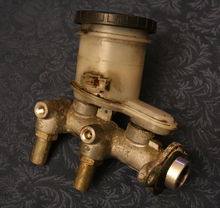- Master cylinder
-
 A master cylinder from a Geo Storm.
A master cylinder from a Geo Storm.
The master cylinder is a control device that converts non-hydraulic pressure (commonly from a driver's foot) into hydraulic pressure, in order to move other device(s) which are located at the other end of the hydraulic system, such as one or more slave cylinders. As piston(s) move along the bore of the master cylinder, this movement is transferred through the hydraulic fluid, to result in a movement of the slave cylinder(s). The hydraulic pressure created by moving a piston (inside the bore of the master cylinder) toward the slave cylinder(s) compresses the fluid evenly, but by varying the comparative surface-area of the master cylinder and/or each slave cylinder, one will vary the amount of force and displacement applied to each slave cylinder (relative to the amount of force and displacement that was applied to the master cylinder).
Vehicle applications
The most common vehicle uses of master cylinders are in brake and clutch systems. In brake systems, the operated devices are cylinders inside of brake calipers and/or drum brakes; these cylinders may be called wheel cylinders or slave cylinders, and they push the brake pads towards a surface that rotates with the wheel (this surface is typically either a drum, or a disc, a.k.a. a rotor) until the stationary brake pad(s) create friction against that rotating surface (typically the rotating surface is metal or ceramic/carbon, for their ability to withstand heat and friction without wearing-down rapidly). In the clutch system, the device which the master cylinder operates is called the slave cylinder; it moves the throw out bearing until the high-friction material on the transmission's clutch disengages from the engine's metal (or ceramic/carbon) flywheel. For hydraulic brakes or clutches alike, flexible high-pressure hoses or inflexible hard-walled metal tubing may be used; but the flexible variety of tubing is needed for at least a short length adjacent to each wheel, whenever the wheel can move relative to the car's chassis (this is the case on any car with steering and other suspension movements; some drag racers and go-karts have no rear suspension, as the rear axle is welded to the chassis, and some antique cars also have no rear suspension movement).
A reservoir above each master cylinder supplies the master cylinder with enough brake fluid to avoid air from entering the master cylinder (even the typical clutch uses brake fluid, but it may also be referred to as "clutch fluid" in a clutch application). Most modern light trucks and passenger cars have one master cylinder for the brakes which contains two pistons; but many racing vehicles, as well as some classic and antique cars, have two separate master cylinders, each with only one piston (much like hydraulic clutches typically have only 1 piston per master cylinder). Each piston in a master cylinder operates a brake circuit, and for modern light trucks and passenger cars, usually a brake circuit leads to a brake caliper or shoe on only two of the vehicle's wheels, and the other brake circuit provides brake-pressure to power the other two brakes. For safety, this is done so that usually only two wheels lose their braking ability at the same time; it results in longer stopping distances and should be fixed immediately, but at least gives some braking ability, which is preferable to having no braking ability.
References
- Nice, Karim: How Master Cylinders and Combination Valves Work, How Stuff Works.
Categories:- Vehicle parts
- Automotive part stubs
Wikimedia Foundation. 2010.
